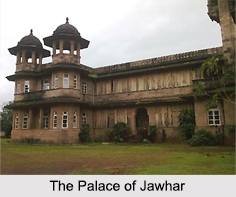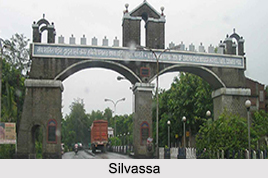 Dadra and Nagar Haveli, union territory of India, located in the western part of the country and situated between the states of Gujarat to the north and Maharashtra to the south. It lies some 24 km from the Arabian Sea and about 130 km north of Mumbai. The territory consists of two sections - Dadra and Nagar Haveli, which together embrace roughly 70 villages. The capital is Silvassa. Area is 491 square km with population of 342,853 (According to Census 2011).
Dadra and Nagar Haveli, union territory of India, located in the western part of the country and situated between the states of Gujarat to the north and Maharashtra to the south. It lies some 24 km from the Arabian Sea and about 130 km north of Mumbai. The territory consists of two sections - Dadra and Nagar Haveli, which together embrace roughly 70 villages. The capital is Silvassa. Area is 491 square km with population of 342,853 (According to Census 2011).
History of Dadra and Nagar Haveli, which is located between Maharashtra and Gujarat traces the political developments of this Union Territory of India, right since the time it was ruled by the Marathas and also the Portuguese. Prior to being joined with the mainland of India, Dadra and Nagar Haveli witnessed the rule of several dynasties.
Ancient History
The history of Dadra and Nagar Haveli begins with the defeat of the Koli chieftains of the region by the Rajput kings. In the year 1262 a Rajput prince from Rajasthan named Ramsinh established himself as the ruler of Ramnagar, the present-day Dharampur, which consisted of 8 parganas (a group of villages) and assumed the title Maharana. Nagar Haveli was one of the Parganas, and its capital was Silvassa.
In 1360 Rana Dharamshah shifted his capital from Nagar Haveli to Nagar Fatehpur
.
With the rise of Maratha power, Shivaji Maharaj viewed Ramnagar as an important locality. He captured the region, but Somshah Rana recaptured it in 1690. After the Treaty of Vasai (6 May 1739), Vasai and the surrounding territories came under the Maratha rule. Soon after, the Marathas captured Ramnagar but reinstated the ruler, Ramdeo, under conditions. Thus the Marathas acquired the rights to collect revenue, known as chauthai from Nagar Haveli and two other Parganas. During the time of Dharamdeo, the son of Ramdeo, due to his change of policies, the Marathas captured Nagar Haveli and the surrounding region.
Medieval History
On the basis of Friendship Treaty executed on 17 December 1779 as compensation towards damage to the Portuguese frigate Santana by Maratha Navy in 1772, the Portuguese were granted the area of Nagar Haveli on 10 June 1783. The treaty allowed the Portuguese to collect revenue from 72 villages in Nagar Haveli. Then, in 1785 the Portuguese purchased Dadra, annexing it to Portuguese India.
In 1818, the Maratha Empire was defeated by the British in the Third Anglo-Maratha War, and the Portuguese ultimately became the effective rulers of Dadra and Nagar Haveli.
Under the Portuguese rule, Dadra and Nagar Haveli were part of the Daman district of the Estado da Ãndia (Portuguese State of India). The two territories formed a single concelho (municipality), named "Nagar Haveli", with its head in Darara until 1885 and, after that, with its head in the town of Silvassa. The local affairs were overseen by an elected camara municipal (municipal council), with the higher level affairs administrated by the district governor of Daman, who was represented in Nagar Haveli by an administrator.
The Nagar Haveli concelho was itself divided in the following freguesias (civil parishes): Silvassa, Noroli, Dadra, Quelalunim, Randá, Darará, Cadoli, Canoel, Carchonde, and Sindonim.
The Portuguese rule lasted until 1954, when Dadra and Nagar Haveli were captured by supporters of the Indian Union. It was the first colony to be detached from the Empire by the occupation of the Indian Union in 1954, after nearly two centuries of Portuguese rule.
Modern History
After India attained Independence in 1947, the residents of Dadra and Nagar Haveli, with the help of volunteers of organisations like the United Front of Goans (UFG), the National Movement Liberation Organisation (NMLO), and the Azad Gomantak Dal, conquered the territories of Dadra and Nagar Haveli from Portuguese India in 1954. As time passed the Indian Independence struggle picked up momentum. On 18 June 1946, Ram Manohar Lohia was arrested in Goa. This was the beginning of the Independence struggle in Goa. He was deported to India. On 15 August 1947, India became independent from British rule, but the Portuguese and other European colonies were not immediately incorporated.
On 18 June 1954, many leaders met at Lavaccha. Lavaccha and Vapi were Indian territories. The order in which these places are lying (from east to west) is Nagar Haveli, Lavaccha, Dadra, Vapi and Daman (on the sea coast). So the Portuguese officers required transit permits through Indian territories of Lavaccha and Vapi to travel between N.H, Dadra, and Daman. On the night of 22 July 1954, 15 volunteers of the United Front of Goans under the leadership of Francis Mascerenhas and Waman Desai sneaked into the territory of Dadra and reached the police station. There are only three personnel at the police station. One was attacked with a knife by one of the volunteers and the other two were overpowered. The Indian tricolour was hoisted and the Indian National Anthem was sung. Dadra was declared "Free territory of Dadra".
On the morning of 2 August 1954, the liberators reached the town of Silvassa to find it free of any Portuguese occupation. The liberation of Dadra and Nagar Haveli was complete. Senhor Luis de Gama, the eldest nationalist hoisted the Indian National Flag and declared the territory of Dadra and Nagar Haveli liberated and the Indian National Anthem was sung.
 In 1961, amidst Indian preparation for the invasion of Goa, Daman, and Diu, K.G. Badlani, an officer of the Indian Administrative Service was, for one day, designated the Prime Minister of Dadra and Nagar Haveli, so that, as Head of State, he could sign an agreement with the Prime Minister of India, Jawaharlal Nehru, and formally merge Dadra and Nagar Haveli with the Republic of India. The Tenth Amendment of the Constitution of India was passed to incorporate Dadra and Nagar Haveli as a union territory, effective 11 August 1961.
In 1961, amidst Indian preparation for the invasion of Goa, Daman, and Diu, K.G. Badlani, an officer of the Indian Administrative Service was, for one day, designated the Prime Minister of Dadra and Nagar Haveli, so that, as Head of State, he could sign an agreement with the Prime Minister of India, Jawaharlal Nehru, and formally merge Dadra and Nagar Haveli with the Republic of India. The Tenth Amendment of the Constitution of India was passed to incorporate Dadra and Nagar Haveli as a union territory, effective 11 August 1961.
On 31 December 1974 a treaty was signed between India and Portugal on recognition of India`s sovereignty over Goa, Daman, Diu, Dadra and Nagar Haveli.
In December 2019, the Parliament of India passed legislation to merge Dadra and Nagar Haveli with the nearby union territory of Daman and Diu to create a single union territory to be known as Dadra and Nagar Haveli and Daman and Diu on 26 January 2020. Dadra and Nagar Haveli will be one of the three districts of the new union territory.
Enclosed by the sea, and the states of Maharashtra and Gujarat is a delightful getaway from the whirlwinds some cities can prove to be. If one wishes to really experience the beauties of nature and meet the people who know how to respect that very same nature, Dadra and Nagar Haveli is the spot for them. Adorned with calm lakes, gardens and a sanctuary to the majestic creatures of the wild. Add to that - the serenity of resplendent churches and temples, it is indeed a splendid destination for all.






